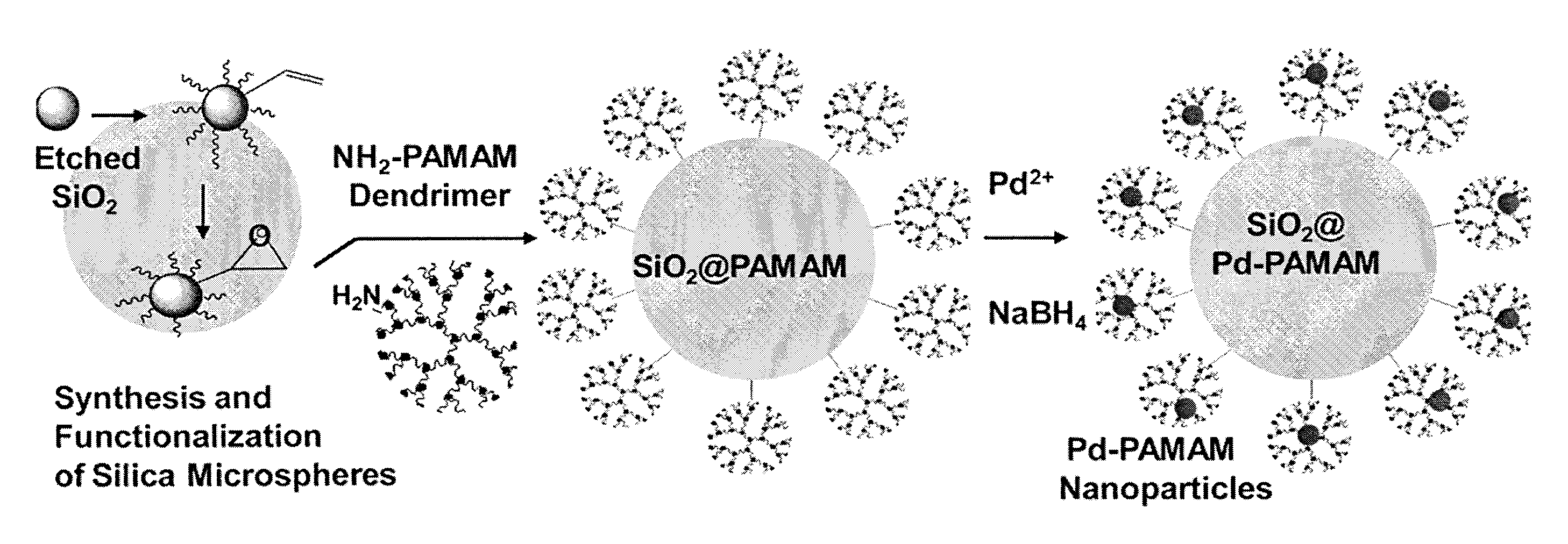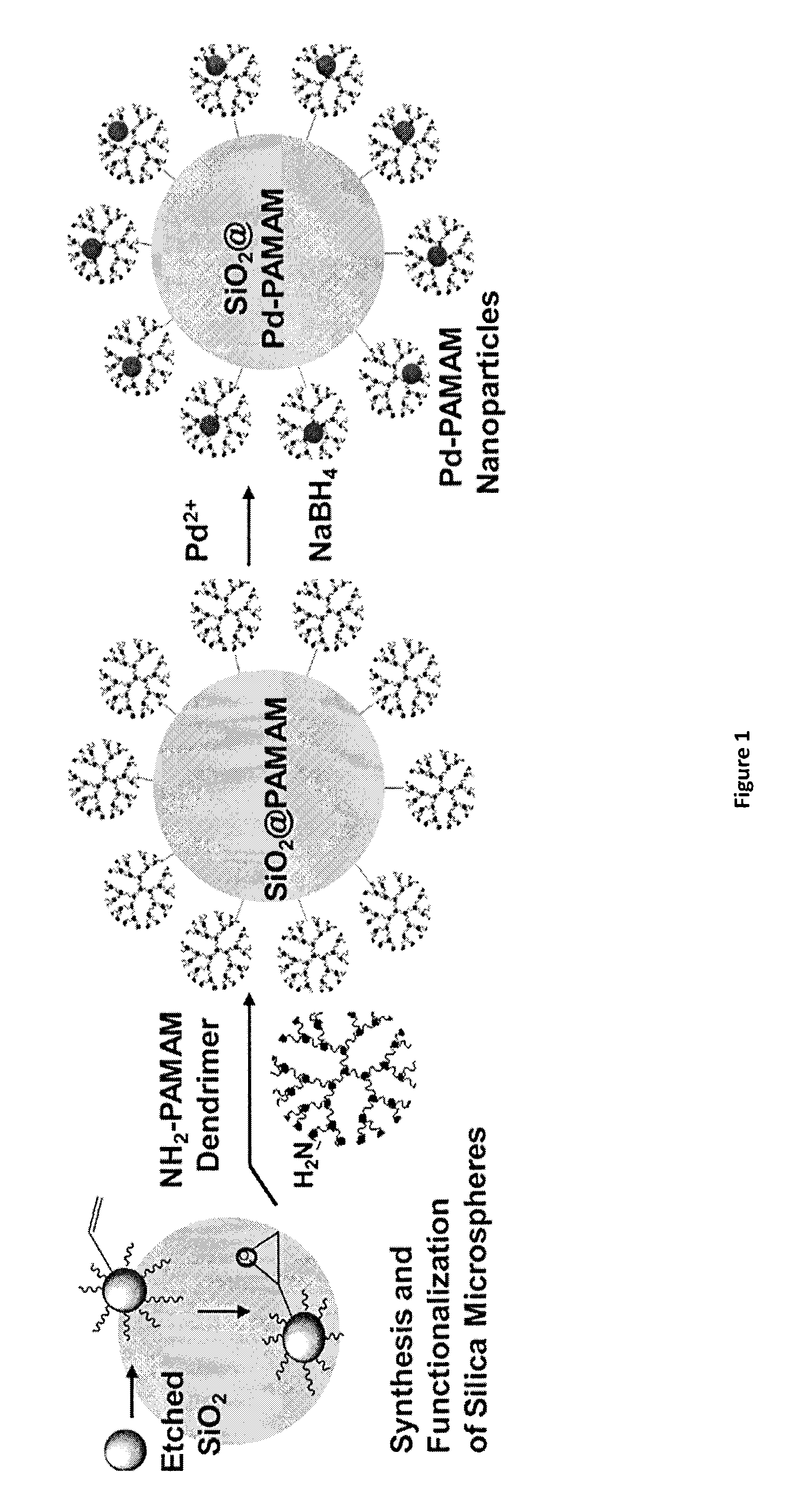Efficient and Recyclable Heterogeneous Nanocatalysts
a nanocatalyst, efficient technology, applied in the field of catalysts, can solve the problems of selectivity, or decrease of intrinsic catalytic activity and selectivity, and achieve the effect of reducing the loss of catalytic activity
- Summary
- Abstract
- Description
- Claims
- Application Information
AI Technical Summary
Benefits of technology
Problems solved by technology
Method used
Image
Examples
example 1
Experimental Section
Chemicals and Reagents
[0089]Anhydrous ethanol, aqueous ammonium hydroxide solution (28%), tetraethyl orthosilicate (TEOS, 98%), Pd / C (1%), sodium borohydride (NaBH4), m-chloroperoxybenzoic acid, styrene, phenylacetylene, potassium hydroxide, cyclohexene, n-hexene, acetone, acetyleacetonate, styrene oxide, 4-chloroaniline, trans-stilbene, 4-nitrostyrene, acetonitrile, methanol, and sodium tetrachloropalladate(II) (Na2PdCl4) were obtained from Sigma-Aldrich. Palladium(II) acetylacetonate (99%) was purchased from Strem Chemicals, Inc. Methylene chloride and hydrochloric acid were obtained from Fisher Scientific. Poly-(amidoamine) (PAMAM) dendrimers (G4) as 10-25% in methanol was obtained from Dendritech NanoTechnologies, Inc., Midland, Mich.
Synthesis of Silica Microspheres
[0090]The synthesis of the spherical silica microspheres was carried out as described (Stober et al. (1968) J. Colloid Interface Sci., 26:62-66; Asefa et al. (2008) J. Mater. Chem., 18:5604-5614). ...
example 2
Experimental
Materials and Reagents
[0118]Anhydrous ethanol, aqueous ammonium hydroxide solution (28%), citric acid and sodium hydroxide (Certified, A.C.S.) were purchased from Fisher Scientific. 3-Aminopropyltriethoxysilane (APTS, 99%) was obtained from Acros Organics. Tetraethyl orthosilicate (TEOS, 98%), sodium tetrachloropalladate(II) (Na2PdCl4), polyvinylpyrrolidone (PVP, MW=˜55000), and dimethyl sulfoxide (DMSO) were obtained from Sigma-Aldrich. Polyvinylpyrrolidone K15 (PVP K15, Mw˜10000) was purchased from Fluka. Unless mentioned otherwise, Millipore water with a high resistivity of 18 M-Ω was used for the synthesis of the materials.
Synthesis of Pd nanoparticles (Pd NP)
[0119]Octahedral shaped Pd-NPs were synthesized as reported (Lim et al. (2007) Angew. Chem. Int. Ed., 46:9279). In a typical synthesis, PVP and citric acid (275 mg) were dissolved in water (8.0 mL) in a 25-mL, three-necked flask containing a Teflon-coated magnetic stir bar and refluxed at 90° C. in air with stir...
example 3
Experimental
Materials and Reagents
[0140]Ethanol (denatured), aqueous ammonium hydroxide solution (28%), citric acid and sodium hydroxide (Certified, A.C.S.) were purchased from Fisher Scientific. 3-Aminopropyltriethoxysilane (APTS, 99%) was obtained from Acros Organics. Tetraethyl orthosilicate (TEOS, 98%), sodium tetrachloropalladate(II) (Na2PdCl4), polyvinylpyrrolidone (Mw ˜55000), Birj 30 and zirconium(IV) n-butoxide Zr(OBu)4 were obtained from Sigma-Aldrich. Polyvinylpyrrolidone K15 (Mw ˜10000) was purchased from Fluka.
Synthesis of Pd Nanoparticles
[0141]First, Pd nanoparticles were synthesized by using an optimum molar ratio of 7.3 mM Na2PdCl4 to 0.13 mM citric acid, and a 5:1 molar ratio of PVP to the Pd precursor in the solution (Lim et al. (2007) Angew. Chem. Int. Ed., 46:9279-9282). In the typical synthesis, 0.40 mol poly(vinylpyrrolidone) (PVP; MW=55,000) and citric acid (1.43 mmol, 0.275 g) were dissolved in water (8.0 mL) in a 25-mL, three-necked flask equipped with a ref...
PUM
| Property | Measurement | Unit |
|---|---|---|
| diameter | aaaaa | aaaaa |
| diameter | aaaaa | aaaaa |
| size | aaaaa | aaaaa |
Abstract
Description
Claims
Application Information
 Login to View More
Login to View More - R&D
- Intellectual Property
- Life Sciences
- Materials
- Tech Scout
- Unparalleled Data Quality
- Higher Quality Content
- 60% Fewer Hallucinations
Browse by: Latest US Patents, China's latest patents, Technical Efficacy Thesaurus, Application Domain, Technology Topic, Popular Technical Reports.
© 2025 PatSnap. All rights reserved.Legal|Privacy policy|Modern Slavery Act Transparency Statement|Sitemap|About US| Contact US: help@patsnap.com



